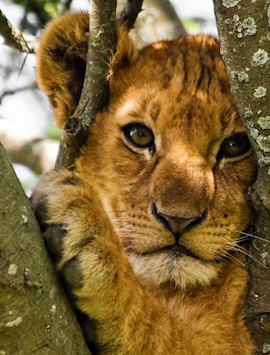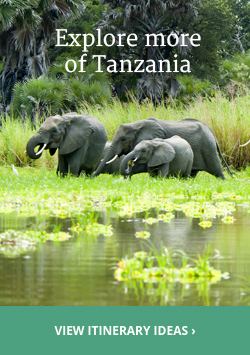
When is the best time to visit Tanzania?
The best time to visit Tanzania depends on what wildlife you’d like to spot. The country’s seasons and wildlife numbers are dictated by the rains, so you’ll have a slightly different experience depending on when you choose to visit.
Tanzania’s headline attraction is the Great Migration, which occurs year-round across the Serengeti. Many people flock here between July and September for a chance to witness huge herds of wildebeest and zebra crossing the Mara River — panic ensues as they try to avoid the jaws of crocodiles and other predators waiting to pounce. You’ll see lots of vehicles in the park at this time of year, though.
Tanzania’s ‘green season’, between November and March, is much quieter. While there’s a chance of rain showers, it’s a fantastic time for birdwatching as migratory species arrive in their thousands. You’ll also see Great Migration herds with their newly born calves.
The only time we tend to avoid Tanzania is between April and May, when heavy rains can disrupt wildlife viewing.
Month-by-month guide for travelling in Tanzania

Visiting Tanzania in January
There is a chance of rain, the temperature is getting higher and the humidity is building. It's still a good time to go as rates are lower and safari is excellent. At this time of year the migration herds are in the southeast of the Serengeti for calving season, so the Ndutu Plains are busy but it is amazing to see so many animals in one place.
Events & Festivals
- Green Season (November to March): Tanzania's Green Season offers superb birdwatching opportunities, with migratory birds arriving in their thousands.

Visiting Tanzania in February
Migration is still occurring in Ndutu. The weather is hot and humid with a chance of rain.
Events & Festivals
- Green Season (November to March): Tanzania's Green Season offers superb birdwatching opportunities, with migratory birds arriving in their thousands.

Visiting Tanzania in March
Migrating herds are starting to leave Ndutu, heading west toward Grumeti. This is truly low season, before the heavy rains but with humidity building. Great rates can be taken advantage of at this time of year.
Events & Festivals
- Green Season (November to March): Tanzania's Green Season offers superb birdwatching opportunities, with migratory birds arriving in their thousands.

Visiting Tanzania in April - May
This is a period of heavy rain, so we would advise against travelling at this time.

Visiting Tanzania in June
This is the green season, bringing lush grasses and bush that can make spotting game more difficult. However, this is still a wonderful time to travel — particularly for bird watchers as parks are full of migratory birds; especially in the south. Migration should be in the Grumeti area of the Serengeti heading north.

Visiting Tanzania in July
This is the start of the peak season. The Migration is in the north of the Serengeti moving toward Kenya, and elephant start to gather in Tarangire. The land is getting drier and spotting game is becoming easier. Temperatures are in the high 20°Cs to early 30°Cs and the humidity is low.
Events & Festivals
- The best chance to observe herds of animals in their hundreds as they cross Tanzania's rivers on their epic journey across the continent is as part of the Great Migration in Africa.

Visiting Tanzania in August
Peak season. Migration is still in the north. As the land becomes more parched, the animals' behaviour becomes more predictable. The dense bush in Ruaha is drying out so game spotting here becomes much easier.
Events & Festivals
- The best chance to observe herds of animals in their hundreds as they cross Tanzania's rivers on their epic journey across the continent is as part of the Great Migration in Africa.

Visiting Tanzania in September
Peak season. The end of the migration is still in the north, with herds on both sides of the Kenya and Tanzania borders and high numbers of elephant in Tarangire. The northern circuit can be very busy, but it is less busy in the south, so for those who want to avoid crowds it's best to visit the southern parks.
Events & Festivals
- The best chance to observe herds of animals in their hundreds as they cross Tanzania's rivers on their epic journey across the continent is as part of the Great Migration in Africa.

Visiting Tanzania in October
Peak season. The migration is now in Kenya, but the game viewing in central Serengeti is still very good. Southern parks are particularly rewarding at this time of year.

Visiting Tanzania in November
Short rains. This is a great time to take advantage of low season rates and is still a popular time to travel. The rains tend to be overnight, but there is a risk of rain during the day as well. Migrating herds are starting to travel south from Kenya, so crossings can be seen in the north of the Serengeti.
Events & Festivals
- Green Season (November to March): Tanzania's Green Season offers superb birdwatching opportunities, with migratory birds arriving in their thousands.

Visiting Tanzania in December
There is a chance of rain, but this is generally overnight. Temperatures and humidity start to build. Safari is good, with migrating herds in the north travelling south to Ndutu. The festive season can be very busy and needs to be planned well in advance to ensure availability.
Events & Festivals
- Green Season (November to March): Tanzania's Green Season offers superb birdwatching opportunities, with migratory birds arriving in their thousands.
Tanzania Climate Guide
| Destination | Jan | Feb | Mar | Apr | May | Jun | Jul | Aug | Sep | Oct | Nov | Dec |
|---|---|---|---|---|---|---|---|---|---|---|---|---|
| Dar es Salaam | 31°C 68mm | 32°C 76mm | 32°C 140mm | 31°C 256mm | 30°C 169mm | 29°C 34mm | 29°C 28mm | 29°C 23mm | 29°C 27mm | 30°C 56mm | 31°C 117mm | 31°C 96mm |
| Mahale Mountains National Park | 24°C 174mm | 24°C 150mm | 24°C 185mm | 24°C 188mm | 24°C 23mm | 24°C 1mm | 24°C 0mm | 25°C 1mm | 26°C 11mm | 26°C 62mm | 24°C 168mm | 23°C 215mm |
| Mount Kilimanjaro | 2°C 168mm | 4°C 165mm | 3°C 296mm | 2°C 327mm | 0°C 172mm | -1°C 63mm | -1°C 64mm | -1°C 71mm | 1°C 67mm | 2°C 172mm | 1°C 296mm | 1°C 235mm |
| Nyerere National Park | 29°C 210mm | 29°C 202mm | 29°C 246mm | 28°C 225mm | 27°C 72mm | 26°C 12mm | 26°C 5mm | 27°C 7mm | 28°C 11mm | 29°C 28mm | 30°C 72mm | 30°C 145mm |
| Ruaha National Park | 28°C 137mm | 28°C 129mm | 28°C 111mm | 27°C 55mm | 27°C 4mm | 26°C 0mm | 26°C 0mm | 26°C 0mm | 28°C 1mm | 30°C 7mm | 30°C 34mm | 29°C 139mm |
| Serengeti National Park | 27°C 94mm | 27°C 99mm | 27°C 136mm | 26°C 137mm | 25°C 64mm | 25°C 27mm | 25°C 12mm | 25°C 25mm | 27°C 31mm | 27°C 42mm | 26°C 96mm | 26°C 111mm |
More choice for your safari
- Inspiration across all our African destinations
- Trip suggestions based on your interests
- Advice on where to safari, when
- Meet our team of safari experts
Travel advice
Practical tips for travelling to Tanzania, from social protocols to guidance on money matters, with a link to the latest FCDO travel advice.

Request our brochure
Covering all seven continents, The World Your Way shows you how you can see the world with us. It features trip ideas from our specialists alongside hand-picked stays and experiences, and introduces our approach to creating meaningful travel experiences.
Trip ideas and travel guides for exploring Tanzania
-
![Lion cub, Lake Manyara National Park]()
-
![Silverback in Group Thirteen, Volcanoes National Park]()
-
What to do in Tanzania: our highlights guide ![A herd of elephant in the Selous]()
What to do in Tanzania: our highlights guide
What to do in Tanzania: our highlights guide
Read this guide -
Trekking holidays in Tanzania ![Mount Kilimanjaro, Tanzania]()
Trekking holidays in Tanzania
Trekking holidays in Tanzania
Read this guide







